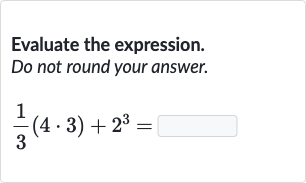Full solution
Q. Evaluate the expression. Do not round your answer.
- Identify Components: Identify the components of the expression.The expression is . It consists of a fraction and an addition of .
- Simplify Fraction: Simplify the fraction part of the expression.The fraction part is . First, multiply the numbers in the denominator: . Then, the fraction becomes .
- Continue Simplifying: Continue simplifying the fraction.Now, multiply to get . So, the fraction is .
- Simplify Exponentiation: Simplify the exponentiation part of the expression.The exponentiation part is . Calculate .
- Add Results: Add the results of the fraction and the exponentiation.Now, add the simplified fraction to the result of , which is . So, the expression becomes .
- Convert to Fraction: Convert the whole number to a fraction with the same denominator to add them.To add to , convert to a fraction with the denominator : .
- Add Fractions: Add the two fractions.Now, add to to get .

